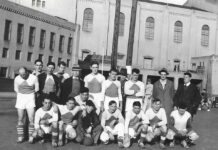For the first 25 years of its existence, only the Congregational Church was allowed in the coal mining town of Black Diamond, but “everybody went to the same church, Catholics and all,” according to Dusalina Cavaletto. About every two to three months Catholic Masses were held in the old show hall when a priest was paid to travel by train from Mount Virgin Church in Seattle and parishioners paid him for coming using the opportunity to baptize their children.
Around 1910, Pacific Coast Coal which owned the company town leased land at nominal rates for a Presbyterian Church, featured in the past two columns, and Saint Barbara’s Catholic Church seen in this Oct. 23, 1910 photo at its dedication performed by Rev. Edward J. O’Dea of the Seattle diocese. At the time of the dedication, flags from the Papal State, Austria and the United States were flown. In Oct. 1939, Pacific Coast gifted this land to the Corporation of the Catholic Bishop of Seattle.
The church was built on an original one-acre lot at Sixth Avenue and Baker Street for $2,227. According to a Sept. 30, 1910 article in the Enumclaw Courier, the lumber was supplied by the White River Lumber Co. of Enumclaw. It was hauled up Lawson Hill from the railroad by two teams of horses driven by Matt Paschich and Pete Veronick. Catholic coal miners loaded the lumber on flat cars and unloaded it at the church site. Ival Parks was the contractor and Alex Gillessen, both of Enumclaw did the painting, but most of the casual labor was provided by parishioners.
The Benedictine fathers of St. Martin’s Abbey in Lacey established the church to bring Catholic services to the many Italian, Polish, and Austrian immigrants who had poured into Black Diamond to work the coal mines. Father Aloysius Mlinar was the person most responsible for its construction. According to Alice DeWinter Shanks, the first couple married at St. Barbara’s Church, were her mother, Cecelia Jones, and father, Philemon DeWinter.
Before St. Barbara’s was built, some Catholics walked three miles along the railroad tracks to the coal mining town of Franklin, having to cross a long trestle at Old Lawson. Franklin’s Catholic Church, beautifully situated directly above the Green River Gorge was built about 1905 but later burned down. The adjacent Holy Rosary cemetery is still actively maintained occasionally hosting a new burial. The bell for St. Barbara’s tower came from the Franklin parish. In 1997, a new and larger church was constructed east of the original chapel that is still used for smaller weddings and weekday masses. The campus now encompasses 6.5 acres.
Saint Barbara is the patron saint of miners comforting them from the dangers they face tunneling deep underground. This prayer hangs in the Black Diamond church: “As I now descend into the dark bowels of the earth, I beseech thee, sweet Barbara, that I be kept safe from harm, for it liketh me not that I rush unbidden into God’s presence.”
This photo comes courtesy of the Black Diamond Historical Society whose volunteers gather each Thursday to improve one of the finest small-town museums in our state. If you’ve never visited, you’re in for a treat while exploring two floors of displays, artifacts, photos, and maps that tell the fascinating story of the little town that could, and still does. Museum hours are Thursday, 9 am to 3 pm, and Saturday-Sunday, 11 am to 3 pm. The museum is located at 32627 Railroad Avenue just a stone’s throw from the famous Black Diamond Bakery, and kitty-corner from the increasingly popular Black Diamond Grill, an Italian-American-inspired restaurant.







